How to Survive in the Wild
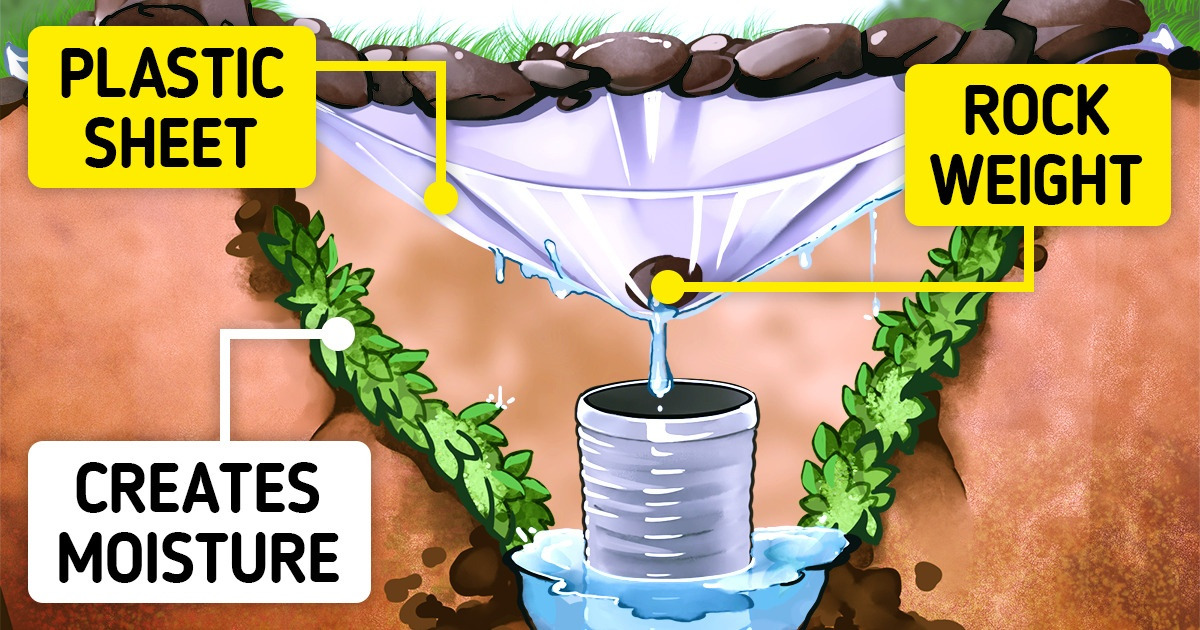
Regardless of the reason, getting lost in the wild is a scary experience that one should try to avoid at all costs. However, in case you take a wrong turn, your car breaks down, or weather conditions change radically, there are some basic things you should be aware of to prevent injury, illness, or even worse scenarios. Here is what 5-Minute Crafts can advise you to keep in mind if you ever happen to be in such a situation.
Basic things you need
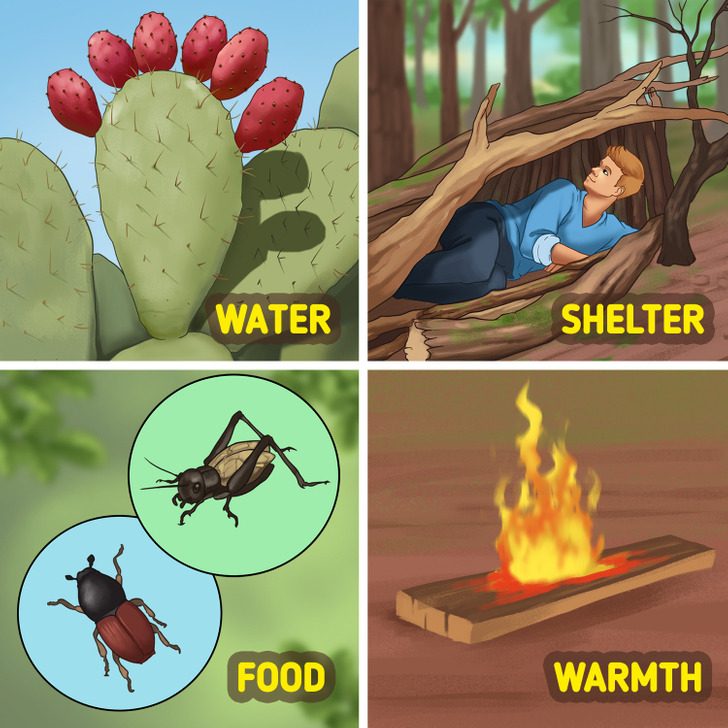
Despite the fact that you may be aware of the dangers or believe you are prepared for a potential incident, you can never actually be fully prepared for a survival situation in the wilderness. However, try not to give in to panic or waste your energy on things that are not essential. Experts claim that there are only 4 basic things that a healthy person needs to focus on to be able to survive in the wild:
- Water
- Shelter
- Food
- Warmth
1. Ways to find water
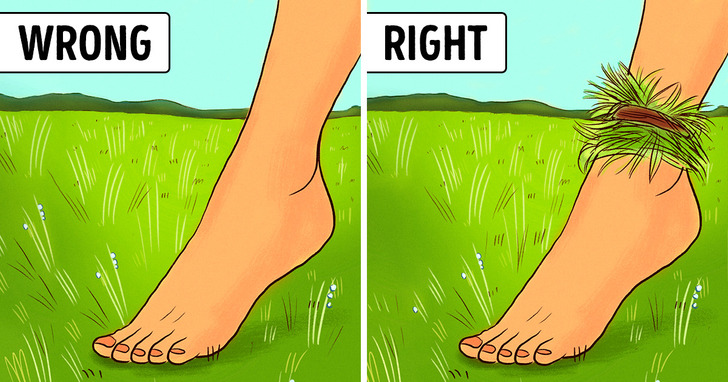
Needless to say, staying hydrated is a lot more important than being fed, since our bodies cannot survive for more than about 3 days without water. This is why the first thing you should think about is finding water. Let’s find out how to do it.
- Wrap dried grass around your ankles while walking before sunrise to collect dew. Indigenous Australian people often use this method.
- Collect the dew using your shirt. Press a shirt or a cloth onto the ground to collect water. Dragging your clothes on the ground is also a good way for them to absorb moisture from the plants. Then wring the cloth out and drink the water.
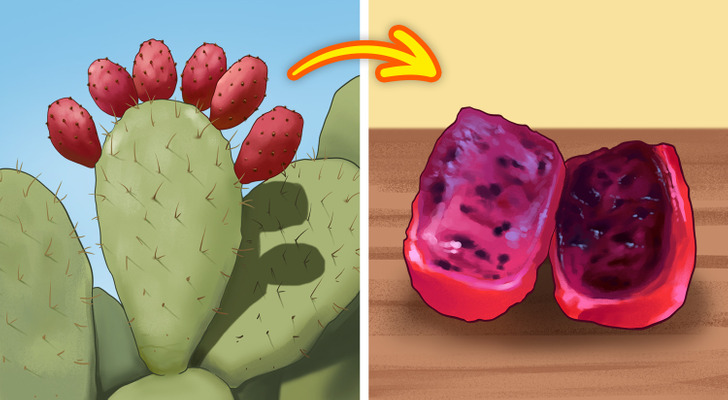
- Pay attention to where ants might be going. Ants can guide you to a water source. Place a piece of clothing into a place they might be heading to collect water.
- Walk parallel to a mountain. There might be a stream or other source of running water.
- Eat cactus fruit. It’s high in water content and edible.
2. Ways to boil water
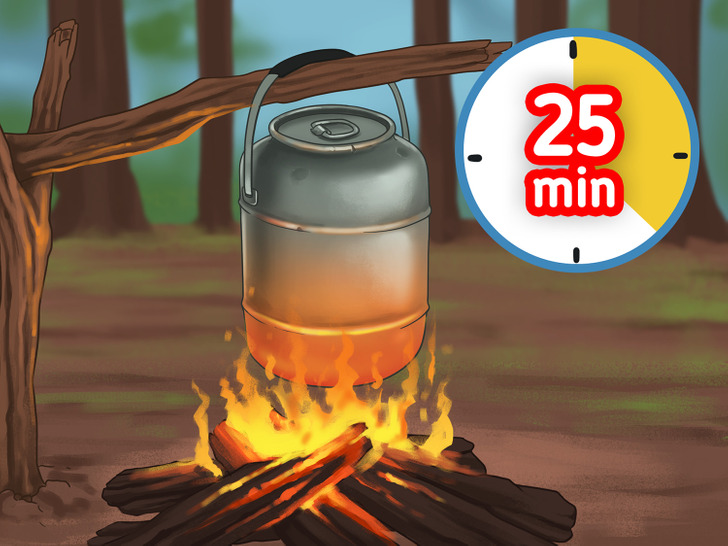
Many people forget that not all water sources you find in the wild are good for you. For example, stagnant water may be unhealthy for you to drink, while running water sources (such as streams or rivers) are surely cleaner. In any case, you should know that sterilizing water before consuming it is always a much safer option. There are 2 smart ways of sterilizing water in the wilderness by boiling it.
- Use a metal container. This is easy — simply put a metal container with water onto the fire (check point #5 to learn how to start one) and let it boil for at least 20 minutes.
- Make a boiling pit yourself. Dig a hole next to a campfire (2 feet long and 2 feet deep) and after separating soil from the clay, make sure you place the clay around the hole without leaving any cracks. Fill the hole with water and add rocks that you previously heated on the campfire for about 10 minutes. As you need steady boiling water, try to mix the hot rocks with those that cooled down.
3. Building a shelter
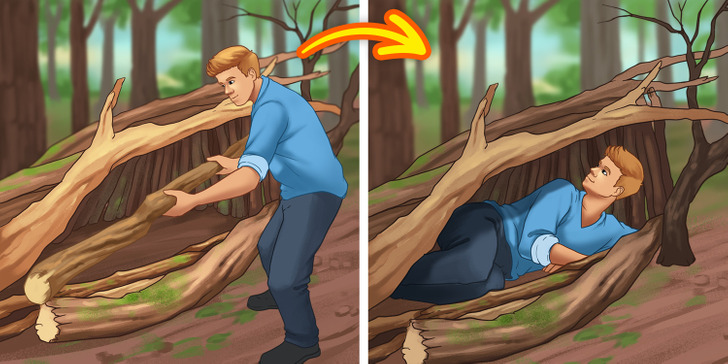
Having a shelter is one of the basic necessities for survival because you need to stay safe from animals and the elements, in addition to staying warm and dry so as not to get sick.
Try to find fallen tree branches (both big and small) or look for rock outcroppings. Pile up longer and thicker branches against a fallen tree or a big rock and fill in the gaps with debris, small branches, and leaves. Cover the soil with leaves and pine needles to keep you warm and remember to replace them daily. Do not worry about the size of your shelter, you can curl up anyway.
4. Finding food
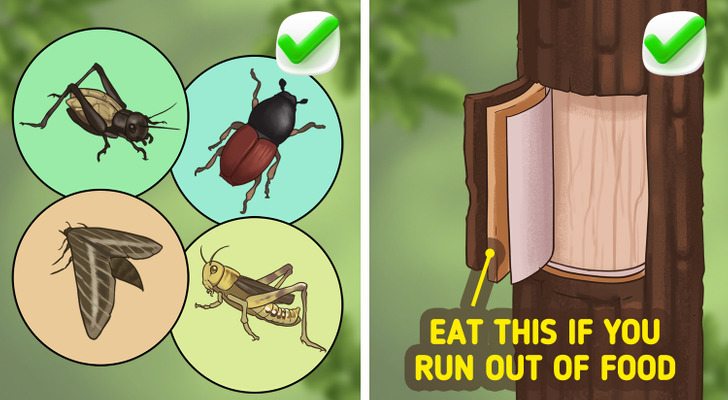
An average person is highly unlikely to catch and cook a wild animal without the proper skills and equipment. It is essential to find other sources of food that are nutritional and require less energy in finding. Make sure you pay attention to the following food sources:
- Bugs (it may seem gross, but bear in mind they are more nutritious than you probably think: bugs and insects are high in protein, calcium, healthy fats, and iron)
- Berries
- Edible bark
- Fish (if you manage to catch any)
- Eggs (if you find them in a bird’s nest and manage to boil them in a specially made coal bed)
- Small mammals, like squirrels or rabbits (again, if you manage to hunt them)
Attention: Avoid wild plants and mushrooms because they can be extremely harmful unless you are completely sure they are edible.
5. Starting a fire
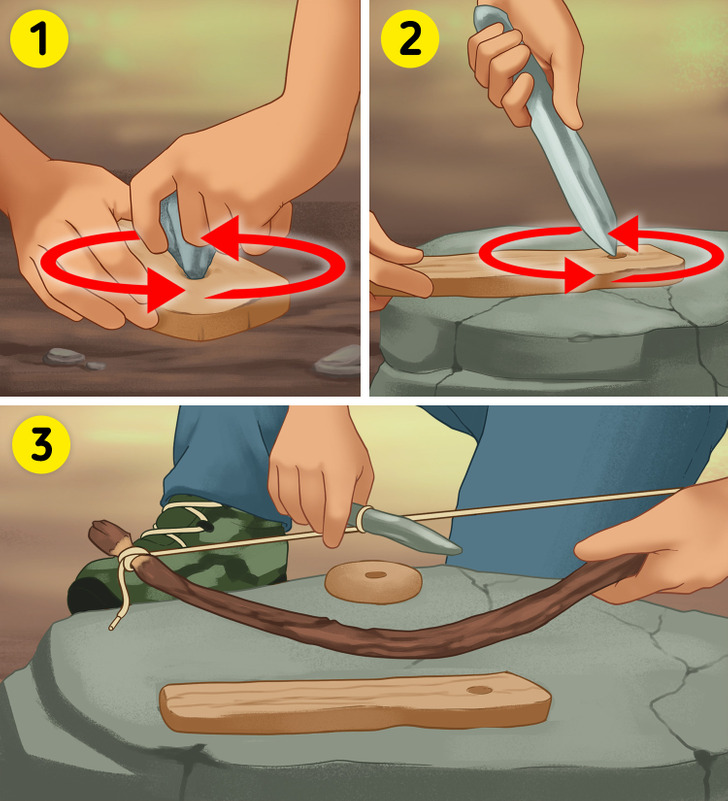
Starting a fire in the wilderness is much easier said than done. The method that is most likely to work in this challenging task is the bow drill method. But first, make sure to prepare a fire pit deep enough not to be ruined by the winds and cover the ground by piling up dry sticks and placing rocks around the pit.
1. To make a bow drill, you first need to find a rock with a divot.
2. You also have to make a hole in a piece of softwood with a sharp rock. Find a long stick or rock that can serve as a drill.
3. Find a flexible or slightly curvy green branch or stick that can serve as a bow. Use a shoelace to tie the ends of it.
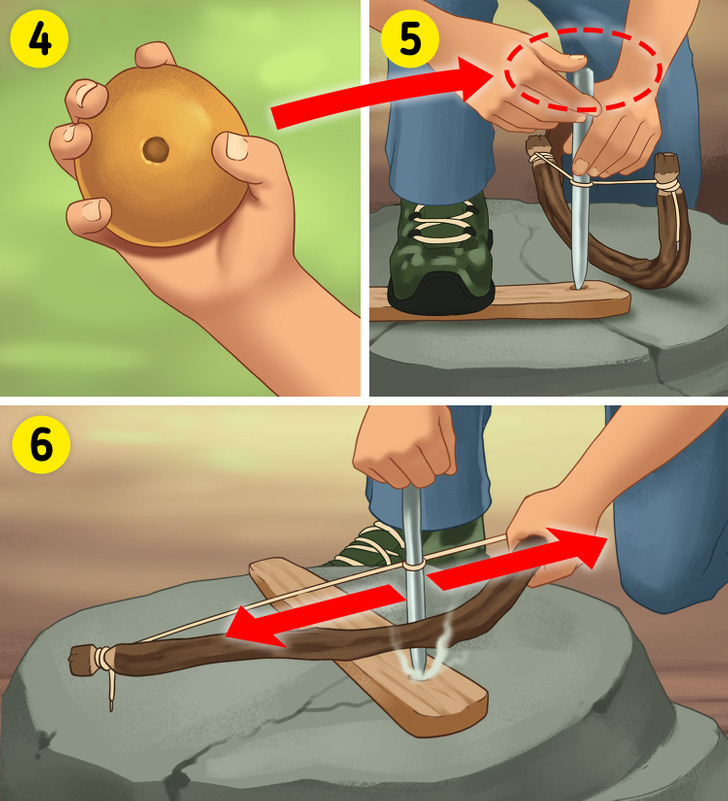
4. Put the rock with a divot to the top of the sharp rock so it rests in the divot.
5. Place the softwood with the drill in the fire pit. Then wrap the string of the bow around it but make only one loop.
6. Keep the bow parallel to the soil. Drawing the bow back and forth while securing the softwood should lead to friction and a spark.
Bonus tips
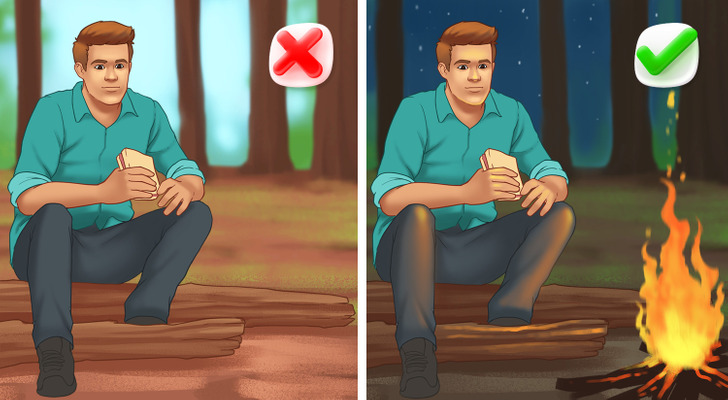
- Follow the “STOP” protocol: stop, think, observe and plan.
- Don’t waste energy, store it.
- Avoid eye contact (in fact, any contact) with wild animals. Move slowly away from them. Wave your arms to seem bigger.
- Eat late to maintain body warmth during the night.
- Mark your path. Pile up stones or mark trees so as not to get lost.
- Cover your skin completely to avoid infections by bug bites.
Bonus: how to collect drinkable water
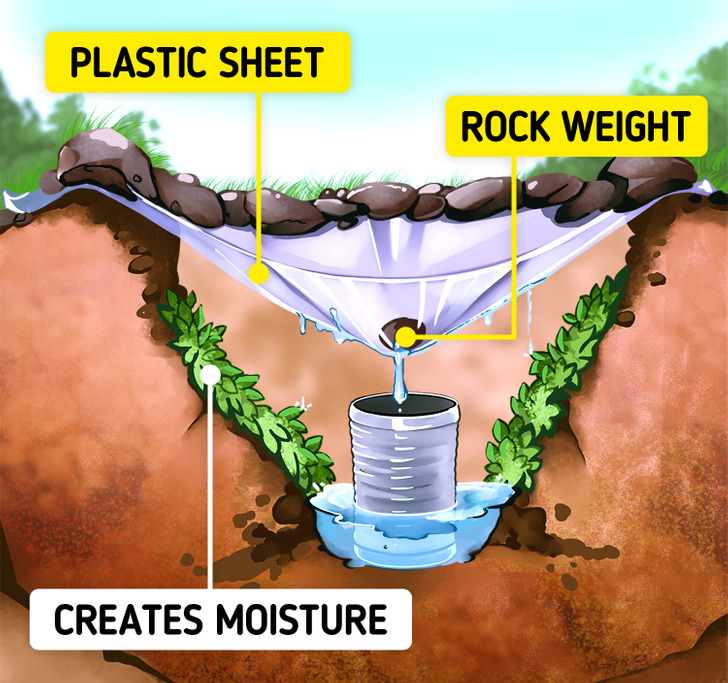
If there is no source of fresh water around you, you can make a belowground still. You will need some plastic sheeting, a container, some rocks, and a digging tool.
- Start with choosing a moist area that gets sunlight for most of the day and dig a hole there about 3 feet across and 2 feet deep.
- In the center of it, make a sump. Place your container into this sump. You can add vegetation inside the hole: it will increase the amount of moisture. But be sure the plants aren’t poisonous.
- Put the plastic sheeting over the hole and fix it from the sides by putting rocks around it.
- Place one rock in the center of the sheet so it can hang down about 18 inches. It should be directly over the container to form an inverted cone. Done!
Let it sit for 12 hours (if you can wait that long) and take your container out — it will be filled with water that can be used for drinking. You can also make a filter to remove any visible particles from it and boil it before drinking.